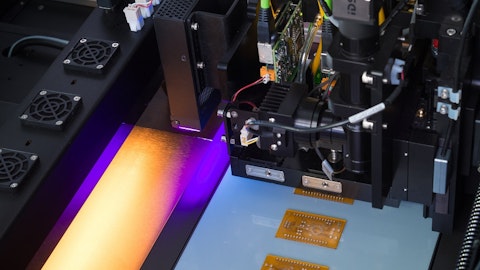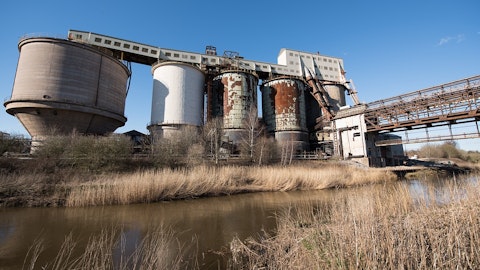The second half of last year was 40% higher in volumes than the first half of last year. So you’ve already seen a lot of the — into destocking that’s occurring there. We’re still not where we want to be, of course, from a market demand point of view but it’s very clear destocking is over. Same is true in a lot of the stable markets, right? Destocking occurred in personal care, water treatment, things like that in the first half of the year. By the tentative back half of the year, we’re already getting to sort of some modest market growth. So for the overall year, demand was relatively flat to ’22 in some of those markets. Building construction, I think, is probably still the most challenged. It was tough last year. The expectation is it’s going to be tough this year, maybe even slightly down in primary demand.
And — but again, I think most of the destocking in that market has played out. By the end of the fourth quarter, there may be little pieces and parts into the first quarter, so you still get that lack of destocking lift in coatings and interlayers across AFP and AM. So I think that, that sort of on a full year basis, sort of how we look at it. And I would note of that $150 million of lack of destocking, 2/3 of it is in Advanced Materials. And the progression, I would say, through the quarter is looking good. So we had a soft start to January, February is already stronger orders in January and March looks good at this point with what we can see. So that’s another point to keep in mind is the first quarter is a pretty slow start, as you can clearly see in our guide.
But there’s a lot of upside as you move into the second quarter from seasonal build. So we do expect a normal seasonal pattern to demand this year. So even though — we’re not saying primary demand is going to be a lot better. First quarter is always softer. Second, third quarter, stronger fourth quarter obviously comes off in a normal pattern for us. And that is how we’ve built our forecast around that. So that helps a lot for why things get better in the second quarter. And then there’s some timing issues as we’ve identified in Fibers and fluids where — particularly low orders in Fluids for especially heat transfer fluids. And then Fibers is a customer buying pattern thing. So those orders get a lot better in second quarter. So there’s several things come together along with some better spread improvements that make second quarter a lot better than first quarter, because I’m sure a lot of people have questions on that as you look at our forecast.
David Begleiter: And just briefly on AFP. You mentioned some negative price cost in 2024. Where are you expecting to see the pricing pressure in AFP?
Mark Costa: So first of all, the spread management last year was great in AFP. So we do have a lot of business on price sort of cost pass-through contracts to give us very stable margins. So it was very helpful in ’22 as raw materials were shooting upward, our prices kept track. And then as prices came off last year, raw material prices came off, the price contracts follow but there’s a lag. So we had an improving spread last year for AFP for the year. And so that was a helpful tailwind to offset some of the volume headwinds we had in that segment. When you look at this year, there’s just a bit of that lag problem again. So you’ve now got prices sort of stabilizing off. And so if you look at spreads this year relative to last year, there’s going to be a bit of a headwind just in the way those sort of cost pass-through contracts work. So that’s the primary driver of the sort of modest spread compression we expect this year relative to last year on AFP.
Operator: Our next question comes from Frank Mitsch of Fermium Research.
Frank Mitsch: And if I could follow up in general on pricing. As you indicated in terms of the cost through, the pass-through contracts, ’22, was a very good year. And as we’re ending ’23 here, pricing has been taking a bit of a hit. So how are you thinking overall about Eastman’s pricing ability in 2024 for the overall enterprise?
Mark Costa: Yes. So first of all, I think it’s important to have a little history around pricing because it really is a pretty impressive story. So if you think about 2020 to ’22, our company had $2.4 billion of inflation. And so we had sort of CPTs trying to keep up to it but there was still a lag that creates a compression and the prices catching up to the increases. But overall, we did an excellent job of getting prices to catch up to all that inflation by the end of 2022 but it did create a compression headwind in chasing it in the specialties in particular, in 2022. So that’s sort of how we entered ’23 is at a pretty high elevation with that inflation. The accomplice to ’22 was compression and we moved into really doing a phenomenally good job.
Our teams were just — really demonstrated great commercial excellence and the real strength of the value proposition of our specialty products and holding prices outside of the cost pass-through contracts in the Specialties. Not to mention we dramatically improved our pricing in Fibers. So when you think about that $450 million of volume headwind we had in ’23 and $50 million of currency, we were able to manage price in ’23 in a very difficult economic environment to entirely offset that in improvements in price relative to variable cost. And a lot of it is structural. So about $300 million of that is in Fibers, based on all the descriptions we’ve given you around where that industry is at as well as a good portion of that is in Advanced Materials in the interlayer business where we had extraordinarily high raw materials in ’22 that we were able to — those raw material prices dropped off or prices held and we got a lot of just recovery back to normal margins in that business.
So we feel really good about that and that basically means there’s sort of $200 million of spread expansion beyond the sort of Fibers, interlayers that you’re managing. So our expectation this year is on the specialties, Fibers is fully contracted. So the prices there are locked. And as we said, business will do a little bit better in earnings versus ’23. In the specialties, what I’d say is that we expect some modest price reductions reflecting how the raw material and energy environment is — has improved. But overall, we would say the spreads in AM and AFP will be similar to last year. So we’re not going to get a tailwind out of it. Maybe there’s a slight compression across those 2 businesses. But we really believe we’ll hold on to our margins with what we see so far, certainly will in the first quarter.
And then we expect to have volume and capacity utilization be the key drivers for recovery and earnings which are pretty substantial. The destocking number I just gave you, $100 million of asset utilization tailwind are pretty significant drivers of recovery this year.





